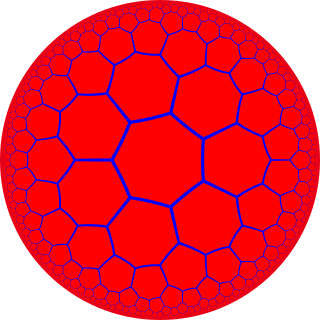Top Qs
Timeline
Chat
Perspective
Heptagonal tiling
Tiling of the hyperbolic plane From Wikipedia, the free encyclopedia
Remove ads
In geometry, a heptagonal tiling is a regular tiling of the hyperbolic plane. It is represented by Schläfli symbol of {7,3}, having three regular heptagons around each vertex.
| Heptagonal tiling | |
|---|---|
 Poincaré disk model of the hyperbolic plane | |
| Type | Hyperbolic regular tiling |
| Vertex configuration | 73 |
| Schläfli symbol | {7,3} |
| Wythoff symbol | 3 | 7 2 |
| Coxeter diagram | |
| Symmetry group | [7,3], (*732) |
| Dual | Order-7 triangular tiling |
| Properties | Vertex-transitive, edge-transitive, face-transitive |
Remove ads
Images
 Poincaré half-plane model |
 Poincaré disk model |
 Beltrami-Klein model |
Related polyhedra and tilings
This tiling is topologically related as a part of sequence of regular polyhedra with Schläfli symbol {n,3}.
From a Wythoff construction there are eight hyperbolic uniform tilings that can be based from the regular heptagonal tiling.
Drawing the tiles colored as red on the original faces, yellow at the original vertices, and blue along the original edges, there are 8 forms.
Remove ads
Hurwitz surfaces

The symmetry group of the tiling is the (2,3,7) triangle group, and a fundamental domain for this action is the (2,3,7) Schwarz triangle. This is the smallest hyperbolic Schwarz triangle, and thus, by the proof of Hurwitz's automorphisms theorem, the tiling is the universal tiling that covers all Hurwitz surfaces (the Riemann surfaces with maximal symmetry group), giving them a tiling by heptagons whose symmetry group equals their automorphism group as Riemann surfaces. The smallest Hurwitz surface is the Klein quartic (genus 3, automorphism group of order 168), and the induced tiling has 24 heptagons, meeting at 56 vertices.
The dual order-7 triangular tiling has the same symmetry group, and thus yields triangulations of Hurwitz surfaces.
See also
Wikimedia Commons has media related to Order-3 heptagonal tiling.
References
External links
Wikiwand - on
Seamless Wikipedia browsing. On steroids.
Remove ads

























